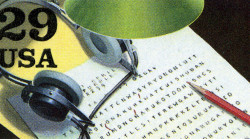Tracie Spinale
Learning Programs Manager
Smithsonian Institution
Middle School (13 to 15 years old), High School (16 to 18 years old), Post-Secondary
Teacher/Educator, Curriculum Coordinator, Parent, Museum Staff
Language Arts And English, Science, Social Studies, Arts, Special Education, Career and Tech Ed, Other
: Museum Studies
Hi there! I am Learning Programs Manager at the Office of the Under Secretary for Education (OUSE) where I focus on positive youth develop programs
Enjoy!
- Positive Youth Development
- 4-H & 4-H Guide to the Smithsonian booklet
- Boys & Girls Clubs of America
- All Access Digital Arts Program - Collections for teens and youth with cognitive differences
- Distance Learning Resources
- A cultural science series from the Smithsonian Arctic Studies Center in Alaska (#arcticstudies)
- Maker and activity collections about environmental and social justice issues
- Topical collections
- A series on the intersection of Buddhism and Western Science
Tracie Spinale's collections
Access Series: Animals - Domestic and Wild!
<p>This topical collection of artworks is all about animals—domestic pets, and wild, untamed beasts. Horses, elephants, dinosaurs, zebras, pandas...cats, hogs, frogs, dogs, lions, tigers, and bears; fish and fowl, monkeys that howl - you'll find all of them here. This collections was originally used in a collage art activity (printed out; using paper, glue, and art materials), and as a discussion prompt in an informal learning activity with a group of teens with cognitive disabilities during a summer camp program. <br><br>Other suggested uses beyond collage and discussion prompts would be a writing exercise, "Which animals have you seen before and where did you see them? If you could have any one of these animals as a pet, which would you choose and why?" Use the visible thinking routine, "See|Think|Wonder" as a starting point for the writing prompt, and the images for inspiration. Also included is a lesson plan which could be adapted for a visit to a natural history museum or zoo.</p>
<p><br> Tags: Decision Making, Disabilities, Self-Determination, Self-Efficacy, Student Empowerment, All Access Digital Arts Program, teens in museums, teens, teenagers, after school, out of school learning, informal learning</p>
 Tracie Spinale
Tracie Spinale
215
Access Series: Collage
<p>This topical collection of artworks is all about collage. Collage is a technique that uses other pieces of artwork assembled into a new artwork. </p>
<p>The collection was originally used in a collage art activity to provide inspiration examples of the art of collage-making, based upon personal interests. It was used with a group of teens with cognitive disabilities during a summer camp program. <br><br> Descriptors: Decision Making, Disabilities, Self-Determination, Self-Efficacy, Student Empowerment, teens in museums, teens, teenagers, after school, out of school learning, informal learning</p>
 Tracie Spinale
Tracie Spinale
29
Access Series: Fantastic Creatures
<p>This topical collection of artworks is based upon "fantastical creatures." It was originally used in a collage art activity (printed out; using paper, glue, and art materials); and as a discussion prompt in an informal learning activity with a group of teens with cognitive disabilities during a summer camp program. <br></p>
<p>Other suggested uses beyond collage and discussion prompts would be a writing exercise, utilizing the "See|Think|Wonder" visible thinking routine or the “Conversing with an Object” discussion prompt as writing inspiration. You could also pair the collection with popular young adult fantasy novels, and ancient myths and legends. Or draw your own fantastic creature.<br><br> Descriptors: Decision Making, Disabilities, Self-Determination, Self-Efficacy, Student Empowerment, All Access Digital Arts Program, teens in museums, teens, teenagers, after school, out of school learning, informal learning</p>
 Tracie Spinale
Tracie Spinale
41
Access Series: Making Music and Sonic Self-Portraits
<p>This inspiration collection of musical people and music instruments was used for a music-making activity and discussion prompt in an informal learning activity with a group of teens with cognitive and intellectual disabilities. Students used GarageBand software to create sonic self-portraits. Prior to the activity, teens were asked about their favorite genres of music, including jazz, blues, classical, rock, pop, rap, and R&B. A lesson plan for making and creating music, and sonic self portraits is also included.</p>
<p>Tags: decision-making, self-determination, student empowerment, disability, All Access Digital Arts Program, #SmithsonianMusic, teens in museums, teens, teenagers, after school, out of school learning, informal learning<br></p>
 Tracie Spinale
Tracie Spinale
43
ACCESS SERIES | Nile, Nile Crocodile
<p><strong>IMPORTANT: Click on the "i" for information icon and the paperclip icons as you move through the collection.</strong><br><br>Exploring: Ancient Egypt, the Nile River, and glass museum objects, paper-craft, and sand art</p>
<p>Rationale for Instruction: <br></p>
<ul><li>Through the introduction, museum visit, and activities, students connect with an ancient and diverse culture in ways both conceptual and concrete. The ancient Egyptians shaped our modern civilization in fundamental ways and left legacies that are still present today. </li></ul>
<p>Objectives:</p>
<ul><li>Explain features of the daily life of an Ancient Egyptian living on the Nile River, including boat transportation, dress, and animal life. </li><li>Explore the ancient origins of glass making in Egypt.</li><li>Examine how glass making relates to object making, animal representation, and the desert environment of Egypt</li><li>Plan, create, and share digital and physical works of art that represent ancient (sand art) and modern art forms (digital photography with filters) as well as representational art (paper-craft) landscape.</li></ul>
<p><strong>EDUCATORS | </strong><strong><a href="https://learninglab.si.edu/q/ll-c/8MmERhz4keCesAxN#r/390900">LESSON PLAN</a> </strong>of the original "Nile, Nile Crocodile" <br>EDUCATORS | For a poem listening and writing activity, visit "<a href="https://learninglab.si.edu/q/ll-c/R4i0dWPqT8ayxkGT">Ozymandias" collection</a><br>EDUCATORS | <em><a href="https://asia.si.edu/wp-content/uploads/2018/03/Exploring-the-Art-of-Ancient-Egypt.pdf">Exploring the Art of Ancient Egypt </a></em>Resource<br><br>SET THE STAGE:<br></p>
<ul><li>Maps - Look at the maps in the Smithsonian collection; Where do you think you'll journey to in this collection?</li><li>"This is Sand" App - an tablet app that changes the pixels on the screen into digital sand.</li><li>Video about The Nile (for learners who prefer a concrete example)</li><li>Thought journey down the Nile River; Ask questions about observations along the way. If you are able to transform the furniture to reflect a boat, do so. </li><li>Glass making video as well as a primary source text from 1904 (for learners who prefer a concrete example); Help make the connection between the desert sand environment and glass making. </li></ul>
<p>MUSEUM "VISIT"<br></p>
<ul><li>Go to the gallery; read the panels and explore the objects. <strong>The gallery has been re-created in the Learning Lab collection</strong></li><li>Explore the glass vessels-->What do you notice?</li><li>Observe the glass animals-->Take turns reading the informational texts; What do the animals represent?</li></ul>
<p>~ BREAK ~<br></p>
<p>ACTIVITY STATIONS (rotate between activity stations)<br></p>
<ul><li>SAND ART - Create your own ancient Egyptian glass vessel through a sand art design similar to the decorated glass in the museum.</li><li>"ANCIENT" PHOTOS - Use digital tablets to take photos in a museum gallery and use the built-in filters to create 'ancient-looking' photos like the ones that document historic museum excavations. </li><li>PAPERCRAFT LANDSCAPE - Create a three-dimensional landscape of ancient Egypt based on the animals and structures observed in the museum gallery and in the introductory materials. Templates and examples are included. Document your results using photography.</li></ul>
<p></p>
<p>Tags: decision-making, self-determination, access, disability, accessibility, neurodiversity, special education, SPED, out of school learning, informal learning, distance learning, cognitive, social skills, engagement, passion, creativity, empowerment, All Access Digital Arts Program, teens in museums, teens, teenagers, after school, out of school learning.</p>
<p></p>
 Tracie Spinale
Tracie Spinale
108
Access Series: Nostalgic Popular "Pop" Culture
<p>This inspiration collection of nostalgic popular "pop" culture from the 1950s, 1960s, 1970s, 1980s, 1990s and 2000s—super heroes and super villains, Muppets, cartoon characters, Star Wars, Disney and Pixar characters, Transformers, and movies was used for a collage activity and discussion prompt in an informal learning activity, "Me & My World: Personal Ecology/Interest Inventory" with a group of teens with cognitive and intellectual disabilities. Students were asked about their favorite pop culture influences from the past and present. <br></p>
<p>Use one of the activity prompts to spark discussion.</p>
<p>Tags: decision-making, self-determination, student empowerment, disability, All Access Digital Arts Program, teens in museums, teens, teenagers, after school, out of school learning, informal learning</p>
 Tracie Spinale
Tracie Spinale
83
ACCESS SERIES | Through the Lens of Curiosity
<p><strong>IMPORTANT: Click on the "i" for information icon and the paperclip icons as you move through the collection.</strong></p>
<p>All Access Club Explores the Microscopic World. If you cannot see something, does that mean that it is not there? Nope! Just lurking under the surface of common, everyday objects is an entire world that we normally cannot see. People just like you can use microscopes to discover things that need magnification in order to view. The collection is part of an activity series that explores this mysterious microscopic world.<br><br><strong>EDUCATORS | </strong>For the LESSON PLAN of the original "Through the Lens of Curiosity" ><br><br>In this collection you will:</p>
<ul><li>Find out about the world through the use of microscopes and magnifiers</li><li>Take on the role of detective as you embark on a quest to solve 5 mysteries -- by making observations about up-close objects and reading clues, can you figure out what the whole object is?</li><li>In the game <em>A Part of the Whole</em>, use your power of observation to consider the structures and functions of up-close objects to guess what they might be. Again, you will look at part of an object--photographed up-close--to guess at the whole.</li></ul>
<p>If it is possible to set-up a hand's-on experience with microscopes along with the online activities -- the tactile portion will enhance the online activity. Teens can also view a video about scanning electron microscopes by a young scientist in the 'extension section'.</p>
<p>Keywords: decision-making, self-determination, access, disability, accessibility, neurodiversity, special education, SPED, out of school learning, informal learning, cognitive, social skills, engagement, passion, creativity, empowerment, All Access Digital Arts Program, teens in museums, teens, teenagers, after school, out of school learning, informal learning</p>
 Tracie Spinale
Tracie Spinale
85
Boys & Girls Clubs of America (BGCA) Guide to the Smithsonian // Activities
<p>The content in this Guide, along with the accompanying online resources and activities in the Smithsonian Learning Lab, features people, places, and things of the Smithsonian Institution around the Boys & Girls Clubs of America (BGCA) themes of: </p>
<ul><li>DEMOCRACY & CIVICS </li><li> DIVERSITY, EQUITY, ACCESS & INCLUSION</li><li> STEM, HEALTHY LIVING & ENVIRONMENT</li><li>SOCIAL IDENTITY</li><li>CAREERS</li></ul>
<p>With over 157.2 million objects and specimens in our collections, we’ve selected <em>some</em> of the most relevant and interesting content the Smithsonian has to offer for BGCA youth and teens based on these topics on or near the National Mall in Washington, D.C. during the Summit for America's Youth. <br></p>
<hr>
<p>BONUS: <a href="https://learninglab.si.edu/q/ll-c/xBNvZo0yH1st2hrY" target="_blank">Smithsonian Career Connections</a></p>
 Tracie Spinale
Tracie Spinale
138
Ciphers and Codes
<p>Throughout history, ciphers and secret codes were devised to keep intelligence from falling into the wrong hands. From the WWII German "Enigma" machine, to America's Cherokee Code Talkers, people used ciphers and codes to safeguard secrets. One of my favorite mysterious artworks is the sculpture <em>Antipodes,</em> outside of the Hirshhorn Museum. No one knows what it means, and its companion piece <em>Kryptos</em> is at Langley. Use this collection an inspiration piece for puzzle lovers and mystery solvers both young and old. There are many free sites on the web that you can use to create your own coded messages like, "Jsotd ymj Qjfwsnsl Qfg!" (Hint: Caesarian Shift).</p>
 Tracie Spinale
Tracie Spinale
25
Color Series - Purple
<p>This topical collection of the color purple is part of a color series and was originally used in a collage art activity (printed out; using paper, glue, and art materials) with a group of teens with cognitive disabilities during a summer camp program. I was inspired to create the series after a few of our students mentioned their passionate interest in specific colors, and how they thought in colors.</p>
<p>Tags: color series, decision-making, self-determination, student empowerment, disability, All Access Digital Arts Program</p>
 Tracie Spinale
Tracie Spinale
30
Color Series: Yellow
<p>This topical collection of the color yellow is part of a color series and was originally used in a collage art activity (printed out; using paper, glue, and art materials) with a group of teens with cognitive disabilities during a summer camp program. I was inspired to create the series after a few of our students mentioned their passionate interest in specific colors, and how they thought in colors<br></p>
<p>Tags: color series, decision-making, self-determination, student empowerment, disability, All Access Digital Arts Program</p>
 Tracie Spinale
Tracie Spinale
30
Creating Personal Narratives - Stories of Migration
<p>Use the creation of mini comics to explore multiple perspectives of the sensitive historical and contemporary issue of migration. Background information explores the multiplicity of immigration realities, and focus on the personal stories that explain why people move. Activity could be adapted to showcase a variety of contemporary topics and teen identity.<br><br>KEYWORDS: immigration, migration, forced migration, Latino, maker, making, comic, zine, teen council, student engagement, identity</p>
 Tracie Spinale
Tracie Spinale
58






















